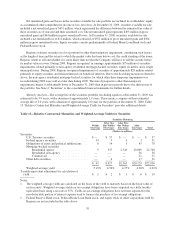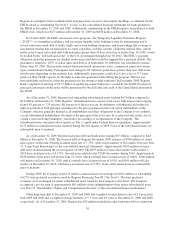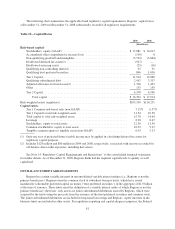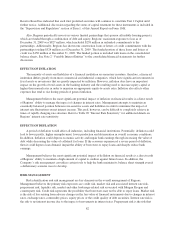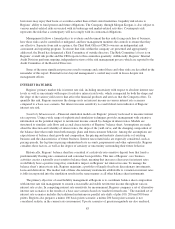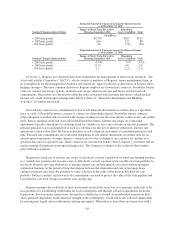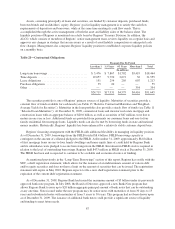Regions Bank 2009 Annual Report Download - page 93
Download and view the complete annual report
Please find page 93 of the 2009 Regions Bank annual report below. You can navigate through the pages in the report by either clicking on the pages listed below, or by using the keyword search tool below to find specific information within the annual report.The Company’s public equity offering of common stock, announced May 20, 2009, resulted in the issuance
of 460 million shares at $4 per share, generating proceeds of approximately $1.8 billion, net of issuance costs.
On May 20, 2009, the Company issued 287,500 shares of mandatory convertible preferred stock, Series B
(“Series B shares”), generating net proceeds of approximately $278 million. Regions will pay annual dividends at
a rate of 10% per share on the initial liquidation preference of $1,000 per share. Series B shares may be
converted into common shares: 1) at December 15, 2010 (the “mandatory conversion date”), 2) prior to
December 15, 2010 at the option of the holder, 3) upon occurrence of certain changes in ownership as defined in
the offering documents, or 4) prior to December 15, 2010 at the option of the Company. At the mandatory
conversion date, the Series B shares are subject to conversion into shares of Regions’ common stock with a per
share conversion rate of not more than approximately 250 shares of common stock and not less than
approximately 227 shares of common stock dependent upon the applicable market price, subject to anti-dilution
adjustments. The Series B shares are not redeemable and rank senior to common stock and to each other class of
capital stock established in the future, and on parity with the Series A preferred stock previously issued to the
U.S. Treasury. In November 2009, a single investor converted approximately 20,000 Series B shares to common
shares as allowed under the original transaction documents. If converted at December 31, 2009, approximately
61 million shares of Regions’ common stock would have been issued.
In addition to the offerings mentioned above, the Company also exchanged approximately 33 million
common shares for $202 million of outstanding 6.625% trust preferred securities issued by Regions Financing
Trust II (“the Trust”). The trust preferred securities were exchanged for junior subordinated notes issued by the
Company to the Trust. The Company recognized a pre-tax gain of approximately $61 million on the
extinguishment of the junior subordinated notes. The increase in shareholders’ equity related to the debt for
common share exchange was approximately $135 million, net of issuance costs and income taxes.
These public offerings along with other capital raising efforts resulted in Regions fully meeting the Tier 1
common equity capital and exceeding the Tier 1 capital requirements prescribed by the Federal Reserve’s SCAP
(see Table 2 “GAAP to Non-GAAP Reconciliation” for further discussion).
At December 31, 2009, Regions had 23.1 million common shares available for repurchase through open
market transactions under an existing share repurchase authorization. There were no treasury stock purchases
through open market transactions during 2009 or 2008. The Company’s ability to repurchase its common stock is
limited by the terms of the Purchase Agreement between Regions and the U.S. Treasury entered into on
November 14, 2008, pursuant to the U.S. Treasury’s Capital Purchase Program. See Part II, Item 5 (“Market for
Registrant’s Common Equity, Related Stockholder Matters and Issuer Purchases of Equity Securities”).
Regions’ ratio of stockholders’ equity to total assets was 12.6 percent at December 31, 2009 compared to
11.5 percent at December 31, 2008. Regions’ ratio of tangible common stockholders’ equity (stockholders’
equity less goodwill and other identifiable intangibles) to total tangible assets was 6.03 percent at December 31,
2009 compared to 5.23 percent at December 31, 2008
Regions attempts to balance the return to stockholders through the payment of dividends with the need to
maintain strong capital levels. After careful consideration of the current environment, Regions reduced its
quarterly dividend to $0.01 in 2009. Given the current operating environment, the quarterly cash dividend was
reduced to further strengthen Regions’ capital position. Regions does not expect to increase its quarterly dividend
above $0.01 for the foreseeable future.
BANK REGULATORY CAPITAL REQUIREMENTS
Regions and Regions Bank are required to comply with capital adequacy standards established by banking
regulatory agencies. Currently, there are two basic measures of capital adequacy: a risk-based measure and a
leverage measure.
79



